How to make a DIY cement and fabric garden vase?
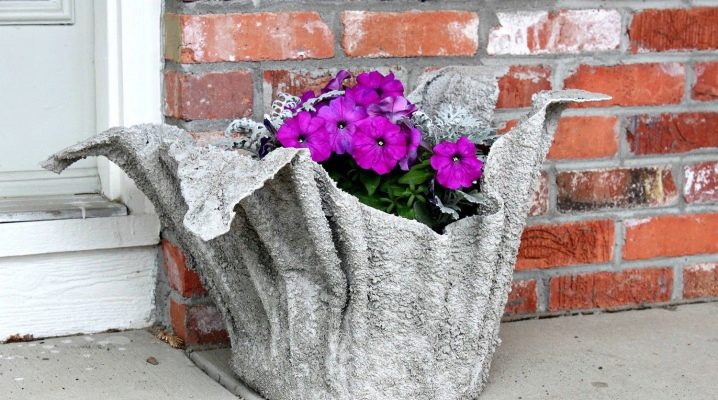
If excess cement remains after the repair, then it can be used to create unique garden vases. For their manufacture, no special components are required, since, in addition to cement, even ordinary towels, which have lost the attractiveness of their original appearance, can be used. How to make a vase for a garden of cement and fabric with your own hands, we will consider in more detail below.

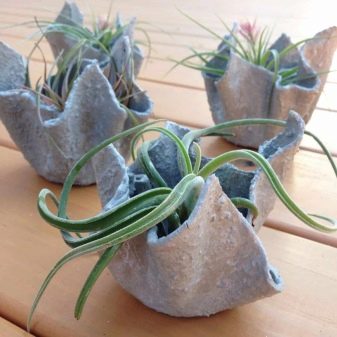
Dimensions, design and shapes
A garden vase can be different: it is both a floor product and a miniature version of the hanging type. The second options are often decorated with verandas, which gives them elegance. The appearance of the future vase will largely depend on:
- existing woven base (towels or other textiles);
- an auxiliary form on which the fabric will be located during drying;
- the quality and quantity of the cement composition prepared for the manufacture of the flowerpot.



If you wish, you can modify the design of the vase so much that outwardly it will not be inferior to exclusive designer models. In this case, the product can have a different shape, volume and size. In addition, during manufacturing, you can achieve a different type of texture, creating a flowerpot not only with a matte, but also with a glossy surface. The type of texture may differ depending on the type of material used.
This explains the difference between vases, say, with a terry relief and a kind of burlap. You can even take tulle or unnecessary lace from curtains as a basis for creating a shape. Someone also uses fringed fabric to create extraordinary flowerpots. Sometimes even old sheets are used to make cement vases.
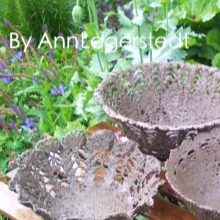


The shape itself can be traditionally round, square, rectangular, conical, trapezoidal, pyramidal, and even cylindrical. If desired, it can be made different (for example, by wrapping the edges and giving them an interesting shape, creating a semblance of large jugs). There are no strict standards in this regard, although the larger the product, the more it needs to be reinforced with reinforcing rings or plates. This will extend its service life when used under natural flowers.
Due to the various shapes and sizes, it is possible to make landscape decor in different stylistic directions. At the same time, the design can be diversified due to decorative elements and embellishment of the mass that has not yet completely solidified. In each case, a special product is obtained. At the same time, you can create several flowerpots in the same style, which, even with different shapes, will make the landscape of the garden plot more interesting. For example, vases may not have supports or may sit on palm-shaped cement substrates.



What is required?
Of course, each master has his own set of components, from which he prefers to make garden flowerpots. As for the optimal or universal option, the work most often requires:
- gray cement or white Portland cement of grades M 400 or M 500;
- sifted and washed fine sand;
- clean or settled water at room temperature;



- color for concrete or a special dye for it;
- container for mixing the working solution;
- electric drill with mixer attachment;
- drill for drainage holes;




- polyethylene film or separating grease (grease);
- form for a future vase;
- fabric (kitchen or terry towel, jute burlap, tulle).



In addition, depending on the type of model, ties may also be needed, through which you can give the future vase a special shape. The prepared container for diluting the cement must be clean and free of grease. It is also important to take care of the cleanliness of the workplace, for which it is worth preparing any covering material (old cardboard boxes or the same thick film, used large plastic bags will do).
As for the material of the form for the future vase, it may be different. A metal bucket, an old flower vase, or even a plastic bowl will do. Someone uses rectangular containers for seedlings, as well as cardboard boxes for the manufacture of garden cement flowerpots. Moreover, sometimes such bases are specially crushed to obtain a more unusual shape. You can use anything that will later be easy to remove, separating the hardened fabric and shape.


Among other things, ordinary rubber gloves often come in handy in the work. They will protect the skin of the hands, make the working process more pleasant and, if necessary, contribute to the formation of the shape of the drying product. Gloves can also be used as a form, wrapping them with a cloth soaked in cement mortar. In addition to gloves, ordinary balloons are also used in the creation of garden vases.



Preparing the solution
It is not difficult to create a grout: it requires fresh cement and water. The proportions can vary, however, on average they are as follows: to create high-quality concrete, 2 parts of peat (or expanded clay, vermiculite) are taken. This amount requires 1 part of sand and 1 part of dry cement. Water is added until the consistency becomes viscous. It should be thinner than for tiled cladding, since the master's task is to completely saturate the fabric with the cement composition.
Cement or concrete is mixed in a prepared bucket using a construction mixer (drill with a special attachment). Then it is left for several minutes, after which it is re-mixed, achieving complete homogeneity of the resulting mixture. It is important that there are no lumps in it, although a different fraction of sand is allowed. After the composition is ready for work, they begin to form a vase.


How to make?
The method of making a vase from cement and fabric depends on the type of form. The standard option is as follows:
- the form is wrapped in plastic wrap, so that in the future it will be easier to remove it from the base;
- install it on a prepared workplace so that it is located securely;
- the prepared fabric (towel, tulle or other piece of old textile) is dipped into the solution and soaked in it;



- without squeezing out the excess mortar, the cement textile is placed on top of the mold, picking up the center of the fabric so that its edges hang more or less equally from all sides;
- you can form folds and tie up the product with ropes or decorative cords, doing this before the composition dries;
- after the cement-impregnated fabric has dried, the vase is removed from the base;
- before decorating, holes are made in the bottom of the finished product for drainage using a stone drill or another drill bit.


The form will have to be installed on a hill. This is to ensure that the edges of the fabric do not drift along the ground. However, if an option with rounded edges is conceived, even rounded stones can be placed around the container in order to give the ends of the future vase the shape of petals. This technique will allow you to straighten the matter, making it wider and giving the necessary folds.
The fabric can be applied on different bases. For example, if there is no suitable shape, you can even use a small round or square countertop. As for the formation of folds, in the case of using lace fabric, they are not needed, since they will only spoil the appearance of the future vase, visually skewing the existing pattern.However, for textiles without relief, it is simply necessary to create folds and folds. Moreover, they can be located not only vertically: if you twist the textiles, you can achieve diagonal folds.


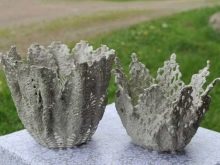
Vases made of cement, concrete and fabric can be used for flowers, decorating the territory of the garden or summer cottage, the foot of the veranda or the area near the gazebo. The cement slurry dries in different ways, depending on the air temperature. Moreover, to strengthen the finished product, the vase will have to be additionally moistened with cool water, which will also extend its durability.
Creating products on a different mold may seem more difficult. However, even in this case, manufacturing is not difficult with the only difference that the vase can provide for wrapping the mold, which will remain the core of the product. Someone thinks that it is possible to make cement vases from fabric without a form, although such a process may seem impracticable to a beginner, because it is somewhat reminiscent of the art of pottery.


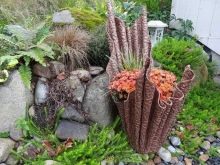
An interesting technique of putting on a burlap on a round base. Such flowerpots can be decorated with just twine, tying them with rough knots. As a rule, two containers are usually used for such a process (one of them must be placed in the other, provided there is free space for pouring the cement mortar). Such vases are made like this: a smaller one is placed on the bottom of a larger container, a cement mixture is poured inside to the brim. After drying, the form is taken out and decorated with burlap soaked in the composition, tied with a rope with impregnation.


Typical vase drying time can vary from 24 to 72 hours. After the product is removed from the mold, it is additionally dried. As a rule, in most cases it has minor flaws that spoil its appearance. You can get rid of drops of cement, as well as the resulting burrs, using sandpaper.
To initially simplify the task of making a garden vase, it is preferable to take white cement and light, almost white sand for work. Of course, such components will cost more. But their use will allow you to decorate the product at your own discretion, without fear that the gray color will change the tones of the dyes or simplify the appearance of the vase when pasting it.


Finished product decor
If the finished result seems incomplete, you can start decorating a garden vase. The easiest decoration option is painting. You can use spray paint for concrete, decorating the inside with one color and the outside with another. It will be difficult to glue colored mosaics or a broken mirror to such vases, so you should look for other ways of decorating.


Someone is used to decorating the outer surface of the vase with shells and small stones. However, due to the special shape with folds and folds, this will be problematic. If you really want to decorate a flowerpot with such elements, you should take care of the shape of the future product in advance, leaving some part of the flowerpot even (for example, an imitation of a garter or belt), where the glued decor will look beautiful and appropriate. You can also specially spread the impregnated fabric in any place in order to later use it for gluing seashells.
Of course, drawing on such models will be quite difficult, and in most cases it is not necessary., because the product will be distinguished by its shape, and, besides it, by the relief due to the selected fabric. And yet, if decoration is needed, in addition to painting, you can come up with other options. For example, you can wind flowers out of fabric, saturate them with cement, and then glue them to the finished product. This decoration is suitable for burlap vases that do not have folds. It is better to place such decor in the upper part.
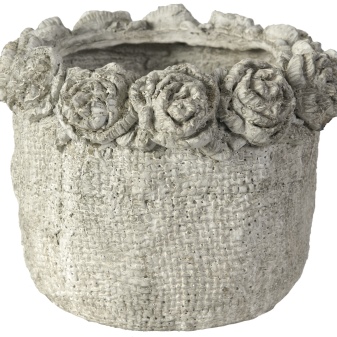

A vase from a bag, put on the appropriate shape and already having a decorative garter, is original in itself.She does not need other decorations, she will look spectacular with fresh flowers. Some products are decorated with cement leaves or even flowers, which are made of a material similar to that of the vase itself. Often, such products look better in one color than painted in bright colors.
You can decorate the bottom with cement leaves and pebbles, giving the product the shape of a flower. For this, you can use not only fabric, but even large leaves, using them as a form. In order for the product to last longer, it is necessary to wash it out, moisten it with water at regular intervals, preventing it from drying out. Of course, this will take more time, but such a vase will be more resistant to bad weather and rain.



Do-it-yourself cement and fabric vases at home can be supplemented with various stands. Someone makes "palms" for them using rubber gloves. Holders for flowers or small vases are made by pouring cement into gloves, after which they are given the desired shape, placing them in cardboard boxes so that the “hands” can hold the vase in the future. After the composition hardens, the rubber base is removed. If necessary, touch up the product with fine sandpaper.


As for the manufacture of a similar shape from fabric (towels) impregnated with cement, it will be problematic for a beginner to do this. Of course, the idea is interesting, but for its implementation, you will have to separately prepare a large form, which in the future will need to be carefully wrapped with thin matter, forming the required volume. Wrapping an ordinary glove with a cloth will also not work, much less a towel.

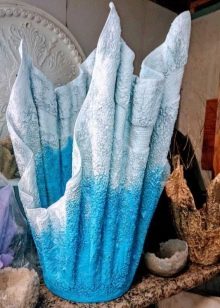

For information on how to make a pot of cement with your own hands, see the next video.













The comment was sent successfully.